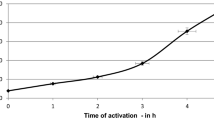Summary
Phytic acid in food is considered to be responsible for a reduced bioavailability of essential dietary minerals; its detrimental effects can be diminished by hydrolysis with phytase during processing. The average phytic acid content was 8.18 mg/g and 3.44 mg/g and average phytase activity was 3.7 U/g and 2.6 U/g in rye kernels and in flour (Type 997, 1.09 ash content), respectively. Phytate and Phytase were about equally distributed between the two kernel halves (cross sections). During the early stages of germination (3 days) phytase activity did not change, and phytic acid content was reduced to 67%. After milling most of the phytic acid and phytase activity were found in the bran fractions. It is concluded that substrate and enzyme are present in the same kernel structures but separate within the cells. Cooking of ground rye caused a phytate hydrolysis which was the more effective 1.) the smaller the particle sizes were, 2.) the more water was added, and 3.) the longer phytase worked at optimum temperature. Extrusion cooking of the rye whole flour at up to 100 °C did not influence the phytic acid level but caused a 23% reduction at 170 °C. Phytase activity was reduced by 80% by extrusion cooking at 80 °C.
Zusammenfassung
Phytinsäure in Lebensmitteln wird für eine verringerte Bioverfügbarkeit von essentiellen Mineralstoffen verantwortlich gemacht; sie kann während der Verarbeitung durch Phytase teilweise abgebaut werden. Der durchschnittliche Phytinsäuregehalt betrug in Roggen 8,18 mg/g und im Mehl der Type 997 3,44 mg/g; im Ganzkornmaterial wurden durchschnittlich Phytaseaktivitäten von 3,7 U/g und im Mehl 2,6. U/g gefunden. In den beiden Kornhälften (quergeteilt) waren Phytat und Phytase etwa gleichmäßig verteilt. Während der dreitägigen Keimung blieb die Phytaseaktivität konstant, der Phytinsäuregehalt nahm um ein Drittel ab. Bei der Vermahlung und dem Schälen von Roggen wurden die größten Mengen an Phytinsäure und Phytase mit Schrot- und Grießkleien bzw. Schälfraktionen entfernt. Es wird daraus geschlossen, daß Substrat und Enzym in den gleichen morphologischen Strukturen, wenn auch intrazellulär getrennt, vorkommen. Küchentechnische Zubereitungsformen von Vollkornprodukten waren für eine Phytatreduzierung um so wirkungsvoller, 1.) je feiner das Getreide vermahlen war, 2.) je mehr Wasser zugegeben wurde und 3.) je länger Phytase im optimalen Temperaturbereich einwirken konnte. Extrusion von Vollkornschrot bewirkte erst bei einer hohen Temperatur ( 170 °C) eine 23%ige Reduktion, während Phytase schon bei 80 °C um etwa 80% geschädigt wurde.
Similar content being viewed by others
Literatur
Cosgrove DJ (1980) Inositol Phosphates-Studies in Organic Chemistry 4. Elsevier, Amsterdam Oxford New York
Cheryan M (1980) CRC Crit Rev Food Sci Nutr 13:297–335
Reddy NR, Sathe SK, Salunkhe DK (1982) Adv Food Res 28:192
Maga JA (1982) J Agric Food Chem 30:1–9
Askar A, El-Samahy SK, Abd El-Fadeel MG (1983) Alimenta 22:131–137
Oberleas D (1983) Cereal Foods World 28:352–357
Tluczkiewicz J, Berendt W (1977) Acta Soc Bot Pol 46:3–14
Tluczkiewicz J, Berendt W (1977) Acta Soc Bot Pol 46:15–30
Harland BF, Harland J (1980) Cereal Chem 57:226–229
Bartnik M, Ceglinska A (1981) Acta Aliment Pol 7:25–34
Torelm I, Bruce Å (1982) Vår Föda 34:79–96
Pedersen B, Eggum BO (1983) Qual Plant, Plant Foods Hum Nutr 32:185–196
Blumenthal A, Scheffeldt P (1983) Mitt Gebiete Lebensm Hyg 74:348–358
Wheeler El, Ferrel RE (1971) Cereal Chem 48:312–320
Piper JM, Lovell SJ (1981) Anal Biochem 117:70–75
Arbeitsgemeinschaft Getreideforschung (1978) Standard-Methoden für Getreide, Mehl und Brot. Verlag Moritz Schäfer, Detmold
Drews E, Fretzdorff B, Ocker HD (1976) Getreide Mehl Brot 38:320–323
Fretzdorff B, Seiler K, Elsner G (1984) Getreide Mehl Brot 38:332–339
Singh B, Reddy NR (1977) J Food Sci 42:1077–1083
O'Dell BL, de Boland AR, Koirtyohann SR (1972) J Agric Food Chem 20:718–721
Fulcher, RG, O'Brien TP, Wong SJ (1981) Cereal Chem 58:130–135
Peers FG (1953) Biochem J 53:102–110
Renzenbrink U (1979) Zeitgemäße Getreide-Ernährung. Rudolf Geering-Verlag, Goetheanum Dornach/Schweiz
Author information
Authors and Affiliations
Additional information
Veröffentl.-Nr. 5342 der Bundesforschungsanstalt für Getreide-und Kartoffelverarbeitung, Detmold
Rights and permissions
About this article
Cite this article
Fretzdorff, B., Weipert, D. Phytinsäure in Getreide und Getreideerzeugnissen. Z Lebensm Unters Forch 182, 287–293 (1986). https://doi.org/10.1007/BF01027626
Received:
Issue Date:
DOI: https://doi.org/10.1007/BF01027626




